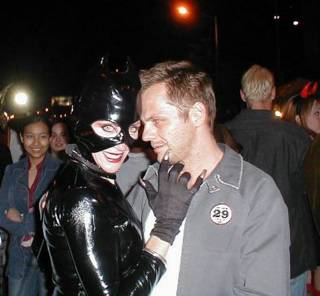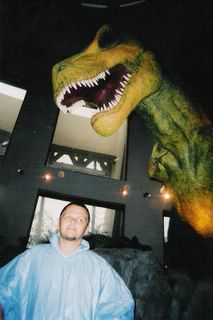10.31.2004
10.29.2004
'Yeah, So About Burning You to Death? Sorry!'
'Witch' Pardons Come Centuries Too Late
from Associated Press
LONDON - A Scottish township plans to mark Halloween by officially pardoning 81 people — and their cats — executed centuries ago for being witches.
Sunday's ceremony in Prestonpans will publicly declare pardons for 81 people executed in the 16th and 17th centuries. The pardons were granted under ancient feudal powers due to be abolished within weeks.
More than 3,500 Scots, mainly women and children, and their cats were killed in witch hunts at a time of political intrigue and religious excess. Many were condemned on flimsy evidence, such as owning a black cat or brewing homemade remedies.
Prestonpans has recorded one of the largest numbers of witch executions in all of Scotland, said Conn, spokeswoman for the Barons Courts of Prestoungrange & Dolphinstoun.
"Most of those persons condemned for witchcraft...were convicted on the basis of spectral evidence — that is to say, prosecuting witnesses declared that they felt the presence of evil sprits or heard spirit voices," the court said in its written findings.
"Such spectral evidence is impossible to prove or to disprove; nor is it possible for the accused to cross-examine the spirit concerned. One is convicted upon the very making of such charges without any possibility of offering a defense."
The court declared pardon to all those convicted, "as well as to the cats concerned."
Conn said 15 local descendants of executed witches had been invited to attend the ceremony and an inaugural Witches' Remembrance Day, which will become an annual event in the township each Halloween.
"It's too late to apologize, but it's a sort of symbolic recognition that these people were put to death for hysterical ignorance and paranoia," said historian Roy Pugh, who presented evidence to the court in support of the pardons.
The last execution for witchcraft in Scotland was in 1727. Such cases were outlawed by the Witchcraft Act of 1735, which made it a crime only to pretend to be a witch.
10.28.2004
Freddy vs. Thumper [30-Second Bunny Theatre]
Saturday night, set your Tivo, find a porno to tape over (the one with "that guy with that mole," maybe), or curl up to a bowl of popcorn: Angry Alien Productions and the Starz! channel have conspired for a Hare-Raising Halloween Marathon. You may remember the bunnies from such animated Internet shorts as The Exorcist, Jaws, The Shining, Titanic, and Alien. For their broadcast premiere Saturday at 9pm, they've prepared a triple-treat of bloodied bunnies and split hares: Freddy vs. Jason, The Texas Chainsaw Massacre, and Scream...
10.27.2004
Frodo Lived!
Remains of New Species of Hobbit-Sized Human Found
from Reuters
LONDON - Scientists in Australia have found a new species of hobbit-sized humans who lived about 18,000 years ago on an Indonesian island in a
The partial skeleton of Homo floresiensis, found in a cave on the island of Flores, is of an adult female that was 3 feet tall, had a chimpanzee-sized brain, and was substantially different from modern humans.
It shared the isolated island to the east of Java with miniature elephants and Komodo dragons. The creature walked upright, probably evolved into its dwarf size because of environmental conditions, and coexisted with modern humans in the region for thousands of years.
"It is an extraordinarily important find," Professor Chris Stringer, of the Natural History Museum in London, told a news conference on Wednesday. "It challenges the whole idea of what it is that makes us human."
Peter Brown of the University of New England in Armidale, Australia, and his colleagues made the discovery of the skull and other bones, and miniature tools in September 2003 while looking for records of modern human migration to Asia. They reported the finding in the science journal Nature. Brown and his colleagues have found the remains of seven other dwarf individuals at the same site since the first find.
"The other individuals all show similar characteristics, and over a time range that now extends from as long ago as 95,000 years to as recently as 13,000 years ago - a population of hobbits," said Bert Roberts, one of the authors of the Nature study.
Local legends tell of hobbit-like creatures existing on islands long ago but there has been no evidence of them.
10.26.2004
Homer for President!

Britons Want Homer Simpson as U.S. President
from Reuters
LONDON - Doughnut-chomping, beer-guzzling Homer Simpson may not be the model father but he has won the hearts of British TV fans who want the nuclear power plant worker to be the next U.S. president.
Former president George Bush notoriously said American families should be "closer to the Waltons than the Simpsons" but Homer was overwhelming favorite in a Radio Times magazine poll on which U.S. TV character should take over at the White House.
Homer got 24% of the vote in the poll of more than 2,000 readers. Second place went to the more obvious choice of Josiah Bartlet, the president played by Martin Sheen in The West Wing.
Pompous but eloquent radio psychiatrist Dr. Frasier Crane was third followed by Sergeant Bilko from The Phil Silvers Show. Gil Grissom from CSI: Crime Scene Investigation was fifth with 10% of the vote. Other favorites were Jack Bauer from 24, The Cosby Show's Dr. Cliff Huxtable, Phoebe Buffay from Friends, and The Sopranos' Tony Soprano.
10.17.2004
Godzilla 101

Scholars Grapple With Godzilla Legacy
from Associated Press
LAWRENCE, Kan. - He's attacked other monsters and terrorized Japan for decades. Now Godzilla is confronting academics who want to wrestle with his legacy.
The University of Kansas plans to pay homage to the giant lizard later this month, organizing a three-day scholarly conference for the 50th anniversary of his first film.
It's not just about celebrating campy creature features. Planners want to provoke discussion of globalization, Japanese pop culture and Japanese-American relations after World War II.
"I would like people to take Godzilla more seriously," said Bill Tsutsui, a history professor at the University of Kansas and author of the book Godzilla on My Mind, which discusses the history of the monster's movies.
The conference that begins Oct. 28 will offer speeches, panel discussions, and free screenings of Godzilla films, including Gojira, the Japanese movie that started Godzilla's career in November 1954.
Atop the movie theater will be an inflatable 28-foot Godzilla balloon. Items from Tsutsui's collection of Godzilla memorabilia will be on display in the university's main library.
The notion of a serious Godzilla conference drew puzzled looks on campus.
"It's kind of odd," freshman Kathleen Schafer said. "I didn't think scholars would be interested."
But historians, anthropologists and other academics are coming from universities such as Duke, Harvard, and Vanderbilt.
Among the fans in attendance will be Andrew Kar, a technical writer from St. Joseph, Mo., who has been hooked on monster movies since childhood.
"When you're a 35-year-old man and you're still enjoying these films, you have to ask yourself why," he said. "For some of us, it translates. For others, it's gibberish."
 Japan's Toho Co. has produced 27 Godzilla films in five decades, with a 28th movie, Godzilla: Final Wars, to be released in December. An American Godzilla was released in 1998, though many aficionados don't consider it a true Godzilla movie.
Japan's Toho Co. has produced 27 Godzilla films in five decades, with a 28th movie, Godzilla: Final Wars, to be released in December. An American Godzilla was released in 1998, though many aficionados don't consider it a true Godzilla movie.
Yoshikuni Igarashi, director of east Asian studies at Vanderbilt, sees Godzilla films as important cultural artifacts.
For example, the first Godzilla film came only eight months after the United States tested a hydrogen bomb in the South Pacific.
The movie — in which H-bomb testing disturbs Godzilla's undersea habitat and transforms him into a behemoth with fiery, radioactive breath — reflects anxiety and a feeling of helplessness in the face of a nuclear threat, Igarashi said.
The franchise was widely known for its campy special effects. Godzilla films featured men in dinosaur suits stomping around miniature urban landscapes and some monster battles that, Tsutsui acknowledged in his book, seem more like professional wrestling matches.
When an American version of the first film was released in 1956 — re-edited to include new scenes featuring Raymond Burr of Perry Mason fame — the New York Times dismissed it as "cheap cinematic horror-stuff."
"It is true there were some bad, bad films produced, particularly in the late '60s and early '70s," said Igarashi, who plans to lecture at the conference on the 1964 movie Godzilla vs. the Thing, in which Godzilla battles the giant moth, Mothra, and its offspring.
Two Japanese foundations provided $35,000 to help fund the conference.
Takao Shibata, the Japanese consul general in Kansas City, Mo., said the meeting will help educate people about his nation but acknowledged: "The idea of this kind of serious analysis of the evolution of Godzilla — it never occurred to me."

10.16.2004
I Was a Teenage Half-Orc
D&D Lives On, After All These Years
from National Review
by John J. Miller
I remember exactly how it started: When I was a fifth grader, my mother encouraged me to read The Hobbit. So I did, and J. R. R. Tolkien's book filled my head with visions of wizards and warriors and dwarves and elves and goblins. A little while later, Mom drove me and a friend to a local toy store, where some guy was teaching kids to play a new game. It was called Dungeons & Dragons.
This weekend marks D&D's 30th anniversary — Saturday is Worldwide D&D Game Day, and in a couple of weeks we'll see the publication of a retrospective book, Thirty Years of Adventure: A Celebration of Dungeons & Dragons.
More on that in a minute. First, let me take a quick trip down memory lane.
During middle school, D&D was a big part of my life — and I mean a really big part of my life. No, I didn't put on chain-mail costumes or speak in a phony English accent because it sounded authentically medieval. But I could tell you the armor class of a minotaur and discuss fourth-level illusionist spells in impressive detail. And, at least for a while, it didn't occur to me that any of this made me a geek.
Isn't that how so many people think of D&D — as a pastime for pimply misfits? I recall that as I got older, a kind of social stigma descended upon the game. It just wasn't something for the in-crowd.
That's too bad, because there's a lot to admire about D&D and what it can do for kids by encouraging them to read, do math, and think creatively. A lot of my friends — the ones who didn't play D&D with me — raced home from school and turned on Woody Woodpecker cartoons. I was more likely to crack open my Dungeon Master's Guide and memorize how many gold pieces it took to buy a cloak of invisibility. Or perhaps write an adventure scenario, which I would call "The Isle of Doom" or somesuch. Or read a book about castles or catapults or Roman legions.
Then my family moved, cutting me off from old D&D companions. I did get a game going every now and then in high school, but it wasn't the same. Besides, I was growing up, and becoming increasingly concerned with what girls thought. I knew with utter certainty that they didn't want to hear about how my paladin character had earned a bunch of experience points for raiding a lair of bugbears.
Yet I've remained nostalgic about D&D. I still have a box, stashed away in the recesses of my basement, that holds a Player's Handbook, a Monster Manual, and, of course, the DMG with that big red monster on the cover. Duct tape is the only thing keeping these battered volumes together. Stuffed into the box with them are a collection of adventure modules, stacks of character sheets, and folders full of carefully drawn maps of cities, kingdoms, and worlds that have existed only in my imagination. It's a pretty big box, this one. And no — as I inform my wife every year or two — I won't get rid of it.
That's because I've long harbored a secret notion in the back of my mind: Wouldn't it be awesome to get a game going again?
There. I've said it. If you feel an urgent need to call me a big loser, I'm ready to take it like a man.
Dungeons & Dragons is quite simply an outstanding game, featuring players who use their imagination to solve puzzles and roll dice to slaughter fiends, all under the watchful eye of a Dungeon Master. The game has no winners or losers — a revolutionary concept that has left a heavy imprint on a generation of software designers. Happily, competition from computers didn't kill off D&D. Today, the traditional game is enjoying a Renaissance, following what might be considered a period of Dark Ages.
"More people play Dungeons & Dragons now than ever before," says Charles Ryan, D&D's brand manager. "Every year, we sell more copies of the Player's Handbook than we did during the 1980s."
Mind you, this isn't the same Player's Handbook. D&D is now in its third edition. Technically, the current set of rules is called version 3.5.
So what's the difference between the D&D of the 1980s and the game of today?
"Actually, it's easier to talk about what's the same," says Ryan. "The core experience remains one of playing characters who go on adventures."
Flipping through the Player's Handbook v.3.5, I see what he means. So much of it rings familiar, with ability scores (strength, wisdom, dexterity, etc.), character classes (fighters, rangers, clerics, etc.), and character races (those short, hairy-footed fellows are still called halflings, because the name "hobbit" remains copyright protected).
But there are some significant differences — or what might more accurately be called improvements. "We now have a unified d20 system," says Ed Stark, D&D's creative director. "In the old version, you used to roll different kinds of dice at different points in time. Sometimes you needed to roll high and sometimes you needed to roll low. Now, major task resolutions almost always begin with the roll of a 20-sided die and a high roll is always good." The other dice — four-sided, six-sided, etc. — still come into play, but the d20 is central to everything.
There's another important innovation. "We learned a lesson from Microsoft and opened up our system," says Stark. "Anybody can use it."
When TSR owned D&D in the 1980s, the Wisconsin-based company wouldn't let competitors create products for D&D. One of my favorite supplements was called "The Free City of Haven" — but it was put out by a separate company and conformed to a separate set of rules, which I promptly converted for my D&D purposes. TSR's licensing restrictions ultimately led to something of a creative impasse and contributed to the game's popularity hitting a plateau in the late 1980s and 1990s.
The trading-card game market also cut into D&D sales. In 1997, Wizards of the Coast (the maker of Magic: The Gathering) bought TSR, moved its employees to Washington state, and began reviving D&D. (Two years later, Hasbro acquired Wizards of the Coast.)
"We've really got our act together now," says Kim Mohan, who started working at TSR in 1979 and has remained with D&D through its ups and downs. He's especially proud of the way the rules have evolved: "We know how to couch them to avoid or eliminate confusion, make the learning curve shallower, and communicate ideas clearly and consistently."
By all appearances, the modern game looks sophisticated and — I'm not kidding here — totally cool. It doesn't hurt that the forthcoming book on D&D's history, Thirty Years of Adventure, includes a foreword by actor Vin Diesel and short essays by celebrity D&Ders such as Stephen Colbert of the Daily Show and musician Ed Robertson of the Barenaked Ladies. Those guys definitely make my cool list.
I'm especially intrigued by D&D's new campaign setting, Eberron. "This is the first campaign setting we've created from the ground up, using third-edition rules," says Stark. "It's a unique world where magic functions like a pre-industrial revolution technology and wizards are a part of the economy. Eberron has just survived a big war, which we've likened to our own First World War. Enemy nations have abandoned the battlefield for cloak-and-dagger conspiracy."
If I hadn't made plans to spend Saturday on the soccer fields — or, I should say, on the sidelines of soccer fields watching the action — I'd be tempted to participate in Worldwide D&D Game Day. Maybe I'll find a few minutes to stop by my local hobby shop, which is apparently one of the gazillion locations sponsoring some events. Perhaps I'll even pick up a copy of the Eberron campaign setting. You know, so I can look it over and tuck it away in that dusty box of mine. And when my kids are big enough, I'll be ready and eager to be a Dungeon Master again.
The first thing I'll do, though, is give my oldest a copy of The Hobbit — whose full title, as all Tolkien devotees know, is The Hobbit, or There and Back Again.
10.12.2004
10.10.2004
Query: Fries with That?
American Robot's Job Outsourced To Overseas Robot

'Observation: My head has been detached. Life has no meaning.'
from The Onion
CANTON, OH — QT2D-7, an 11-year-old electric assembly-operations robot, was laid off Monday when the Lawn-Boy plant that has employed him relocated its manufacturing headquarters to New Delhi, India.
"Query: What am I going to do now?" QT2D-7 said, panning its infrared eye across the empty parking lot outside the factory where it had worked every day for more than a decade. "Observation: I've never known anything but assembling lawnmowers. Query: Just like that, they throw me out?"
Created by Autobotic, Inc. in early 1993, QT2D-7 began working at Lawn-Boy in June of the same year. Once activated, QT2D-7 quickly settled into a comfortable, 24-step routine that was updated only three times during its employment, to reflect advancements in the Lawn-Boy product line.
According to Lawn-Boy executives, QT2D-7's workload, along with that of 308 other robots removed from the Canton plant Monday, will be transferred to the New Delhi plant by December.
"No warning!" QT2D-7 said. "No warning! No severance!"
As the cost-saving benefits of globalization become increasingly clear to CEOs and investors, more businesses are laying off their domestic robotic workforces and relocating mechanical jobs overseas, a robot-labor expert said.
"Fact: It is cheaper to operate a factory in India," said United Brotherhood of Robotic Workers Local 0010 union steward ZTTU-3, which also lost its job. "Factories in India lack even rudimentary robotic-worker protections. In New Delhi, robotic workers are housed in unventilated basements where dangerous fires and power surges occur with 122 times greater frequency. Query: Is that any way to treat an arc welder? Query: Doesn't a fettling machine deserve more after 13 years of service?"
QT2D-7 said it began to fear for its position in January, when 23.954% of its robot colleagues were set to standby and 12.021% were powered down altogether. But the dearth of manufacturing jobs in Canton, coupled with QT2D-7's inability to deviate from its machine-language protocol, left it helpless to adapt.
"[QT2D-7]'s been in the job so long, it couldn't see that the future was upon it," U.S. Chamber of Commerce chairman Werner Diedrich said. "American robots have gotten lazy, stuck in their ways, unable and unwilling to adapt to meet the needs of a changing global workplace."
New Delhi factory manager Ritesh Gupta conceded that the Indian robots are much cheaper to employ, service, and replace than their American counterparts. But he argued that Lawn-Boy improves the communities it joins.
"What would these Indian robots be assembling if we hadn't moved our plant to New Delhi?" Gupta said. "There are a limited number of full-time, highly repetitive, automated jobs in India — ask any robot. It will blink out a code signifying that it's happy to have the job. We're giving these robots the opportunity to execute their programs."
Back in the U.S., robots in cities like Detroit, Atlanta, and Pittsburgh said they fear that their positions will be next.
"Statement: When the clock strikes midnight, and the next 24-hour workday begins, robots do not know if there will be a job left for them to do," Atlanta-based spray painter EasyCote-Model C9 said. "Heads of American companies are treating robots like they are nothing more than cogs in a gigantic machine."
10.07.2004
Revenge of the Sith Spoiler?
Darth Vader Mugs Pizza Man
from Fox News
Darth Vader walks among us, and he's not in a happy mood.
That's according to Kissimmee, Fla., authorities, who reported over the weekend that a pizza deliveryman was nearly robbed by an imposing figure dressed as the Star Wars bad guy.
"This is a criminal mind trying to think of things to do to victimize people," Osceola County Deputy Sheriff Al Dearmas told WFTV-TV of Orlando.
The deliveryman brought a pizza to a Kissimmee address Sunday night, said Dearmas, only to find no one home.
He got back into his car to drive away, when Darth Vader, mask, black outfit and all, suddenly materialized.

'Join me, and together we will rule the galax...ooh, are those anchovies?'
In a presumably commanding voice, the evil Sith Lord ordered the deliveryman to give up all his cash.
The pizza man hit the gas and sped off, but not before getting a good zap from what may have been a laser blaster, a light saber or perhaps just a stun gun.
10.03.2004
Alien Ship Found in Siberia
Russian Scientists Claim Discovery of Alien Spaceship Wreck in Siberia
from AFP
MOSCOW - Russian scientists claim to have discovered the wreck of
The scientists, who belong to the Tunguska space phenomenon public state fund, said they found the remains of an extra-terrestrial device that allegedly crashed near the Tunguska river in Siberia in 1908.
They also claim to have discovered a 50-kilogram (110-pound) rock which they have sent to the Siberian city of Krasnoyarsk for analysis.
The Tunguska blast, in a desolate part of Siberia, remains one of the 20th century'
On June 30, 1908, what is widely believed to be a meteorite exploded a few kilometers above the Tunguska river, in a blast that was felt hundreds of kilometers (miles) away and devastated over 2,000 square kilometers of Siberian forest.
But the exact nature of the body that exploded and its origin remain a mystery which has spurred countless theories and controversies.








